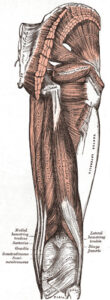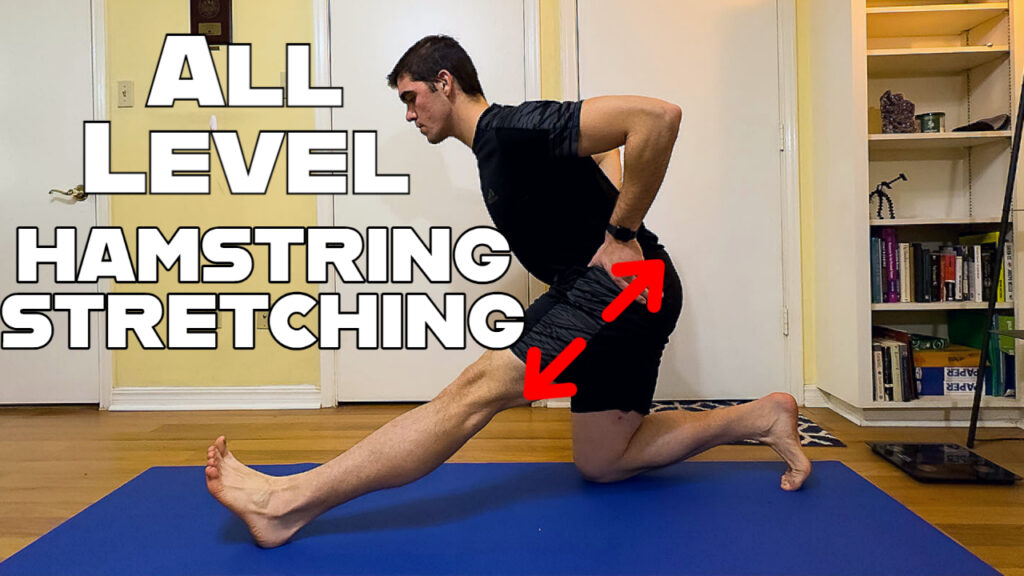If you struggle to bend over for daily tasks or feel tightness or pain in the back of your thigh, you may benefit from these stretching exercises. Tight hamstrings can be caused by sitting for prolonged periods of time without varied movement and can be painful. These stretches are aimed at all fitness and skill levels and are in order of the easiest to hardest.
What Are The Hamstrings?

The hamstrings are the semimembranosus, semitendinosus, and biceps femoris and these muscles function to bend the knee and extend the hip. You can think about the hamstrings connecting below your knee at the top of your leg and running up your leg to attach to the bone you sit on.
Tips for Hamstring Stretching
- When you bend over, use your hip as a hinge and not your spine.
- Hamstring stretches should be conducted with the hip bent and the knee straightened because the muscle crosses both joints.
- For the best results, warm up before stretching.
- Going for a walk, hitting up the sauna, or even stretching after a workout will allow deeper and safer stretching.
- Avoid ballistic movements as a beginner or if you are at risk of injury. The point of stretching is to meet your body where it is at when you begin so ease into it and progress over time.
- Grade the intensity of the stretch using your own force aim for a 4-6/10 for 30 seconds. Repeat for 1-4 sets.
Sitting Knee Prop

- Kick the stretch leg out, bringing your heel to the ground with a straight knee.
- Bring your chest to your knee bending at your hip and not your back.
- Hold for at least 30 seconds.
- Stretch intensity should be at least a 4-6/10
- If the stretch is too intense or painful, point your toes to the ground to focus on your hamstring purely.
Kneeling Hamstring Stretch

-
- The toe of the back leg is pointed into the ground for stability. Tighten your core and glutes for added stability during the stretch.
- Keep your neck and back straight.
- Breathe deeply through the stretch for 30 seconds.
- If the stretch is too intense you can point the toe to take the calf muscle out of it.
Straight Leg Raise

- Wrap a belt or towel under your forefoot to include the calf muscle.
- Alternatively, for the no strap option; hold the leg behind the knee and think about keeping the knee straight during the stretch.
- Pointing your toes toward your face can stretch the sciatic nerve and can help healthy individuals.
Standing Hamstring Stretch

- Bring the feet together or shoulder width and hinge forward at the hip while pushing your rear backward.
- Keep your back and knees straight until you hit a plateau.
- After you reach the limit of your hamstrings to intensify the stretch, grab your ankles and bring your chest to your knees.
Frequency of stretch
- The goal of stretching is to reduce your risk of injury, relieve pain, and become more functional. Whatever your goal of stretching may be, listen to your body in order to balance inflammation in a sweet spot to not increase swelling and decrease the effectiveness of the stretches.
- 3-7 stretches per week may be best focusing on every day if the stretch intensity is moderate.
- 1-3 days a week if your intensity of stretching is high.
MY KEY LINKS:
- 📺 YouTube – https://www.youtube.com/@cartergansky
- 📸 Instagram – https://www.instagram.com/cartergansky/
- 🐦 Twitter – https://twitter.com/CarterGansky
- 🌲 Linktree – https://linktr.ee/cartergansky
- 🔊 Discord – https://discord.gg/sQxvHH78Ga
WHO AM I?:
-
- I’m Carter, a fitness and health advocate, YouTuber, blogger, and Doctor of Physical Therapy in training. Follow me as I explore the strategies and tools that help us live motivating, healthier, and more fulfilling lives.



